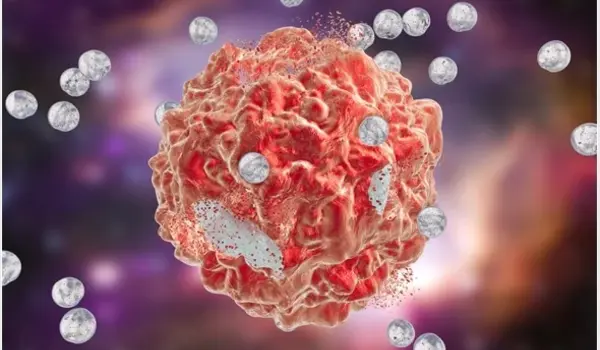Nanoparticles are small particles that have been widely studied for their potential applications in medicine, particularly in drug delivery. Multidrug nanoparticles are nanoparticles that are designed to deliver multiple drugs to a specific target in the body.
Cancer is a complex disease that often requires multiple drugs to be administered in combination to achieve the best therapeutic outcome. However, the use of multiple drugs can lead to increased toxicity and side effects, as well as the risk of drug resistance. Multidrug nanoparticles offer a promising solution to these challenges by allowing for the targeted delivery of multiple drugs to cancer cells while minimizing toxicity to healthy tissues.
Chemists created a bottlebrush-shaped nanoparticle that can be loaded with multiple drugs in easily controllable ratios. The researchers calculated and delivered the optimal ratio of three cancer drugs used to treat multiple myeloma using these particles.
Combining drugs to treat cancer can be more effective than using a single drug alone. However, determining the best drug combination and ensuring that all drugs reach their intended target can be difficult.
To address these issues, MIT chemists created a bottlebrush-shaped nanoparticle that can be loaded with multiple drugs in easily controlled ratios. The researchers were able to calculate and then deliver the optimal ratio of three cancer drugs used to treat multiple myeloma using these particles.
There’s a lot of interest in finding synergistic combination therapies for cancer, which means that they leverage some underlying mechanism of the cancer cell that allows them to kill more effectively/
Jeremiah Johnson
“There’s a lot of interest in finding synergistic combination therapies for cancer, which means that they leverage some underlying mechanism of the cancer cell that allows them to kill more effectively,” says Jeremiah Johnson, an MIT professor of chemistry and one of the study’s senior authors.
In a mouse study, the researchers discovered that nanoparticles containing three drugs in the synergistic ratio they discovered shrank tumors significantly more than when the three drugs were administered in the same ratio but untethered to a particle. According to the researchers, this nanoparticle platform has the potential to be used to deliver drug combinations against a variety of cancers.
Irene Ghobrial, a professor of medicine at Harvard Medical School and Dana-Farber Cancer Institute, and P. Peter Ghoroghchian, president of Ceptur Therapeutics and a former MIT Koch Institute Clinical Investigator, are also senior authors of the paper, which appears today in Nature Nanotechnology. Alexandre Detappe, an assistant professor at the Strasbourg Europe Cancer Institute, and Hung Nguyen Ph.D. ’19 are the paper’s lead authors.

Controlled ratio
Because the particles prevent the drugs from being released prematurely, using nanoparticles to deliver cancer drugs allows the drugs to accumulate at the tumor site and reduces toxic side effects. However, only a few nanoparticle drug formulations have been approved by the FDA to treat cancer, and only one of these particles contains more than one drug.
Johnson’s lab has been working on polymer nanoparticles designed to carry multiple drugs for several years. The research team concentrated on a bottlebrush-shaped particle in the new study. Drug molecules are inactivated by binding to polymer building blocks before being mixed together in a specific ratio for polymerization. This forms chains that extend from a central backbone, giving the molecule a bottlebrush-like structure with inactivated drugs – prodrugs – along the bottlebrush backbone. Cleavage of the linker that holds the drug to the backbone releases the active agent.
“If we want to make a bottlebrush that contains two, three, or any number of drugs, we simply synthesize those different drug-conjugated monomers, mix them together, and polymerize them. The resulting bottlebrushes are exactly the same size and shape as the bottlebrush with only one drug, but they now have a distribution of two, three, or however many drugs you want within them “According to Johnson.
In this study, the researchers first tested particles containing only one drug: bortezomib, which is used to treat multiple myeloma, a cancer that affects a type of B cell known as plasma cells. Bortezomib is a proteasome inhibitor, a type of drug that prevents cancer cells from breaking down the excess proteins they produce. Accumulation of these proteins eventually causes the tumor cells to die.
When bortezomib is given on its own, the drug tends accumulate in red blood cells, which have high proteasome concentrations. However, when the researchers gave their bottlebrush prodrug version of the drug to mice, they found that the particles accumulated primarily in plasma cells because the bottlebrush structure protects the drug from being released right away, allowing it to circulate long enough to reach its target.
Synergistic combinations
The researchers were also able to analyze many different drug combinations using the bottlebrush particles to determine which were the most effective. Researchers currently test potential drug combinations by exposing cancer cells in a lab dish to different concentrations of multiple drugs, but the results do not always translate to patients because each drug is distributed and absorbed differently inside the human body.
“If you inject three drugs into your body, the chances of the correct ratio of those drugs reaching the cancer cell at the same time are extremely low. The drugs have different properties that cause them to travel to different locations, which greatly impedes the translation of these identified synergistic drug ratios” Johnson claims.
However, delivering all three drugs together in one particle could potentially overcome that obstacle and make it easier to deliver synergistic ratios. Because of the ease of creating bottlebrush particles with varying concentrations of drugs, the researchers were able to compare particles carrying different ratios of bortezomib and two other drugs used to treat multiple myeloma: an immunostimulatory drug called pomalidomide, and dexamethasone, an anti-inflammatory drug.
Exposing these particles to cancer cells in a lab dish revealed synergistic combinations, but these combinations differed from the synergistic ratios discovered using drugs not bound to the bottlebrush.
“What this tells us is that whenever you’re trying to develop a synergistic drug combination that you eventually plan to administer in the context of a nanoparticle, you should measure synergy in the context of the nanoparticle,” Johnson says. “You can’t guarantee it will be as effective if you measure it for the drugs alone and then try to make a nanoparticle with that ratio.”














